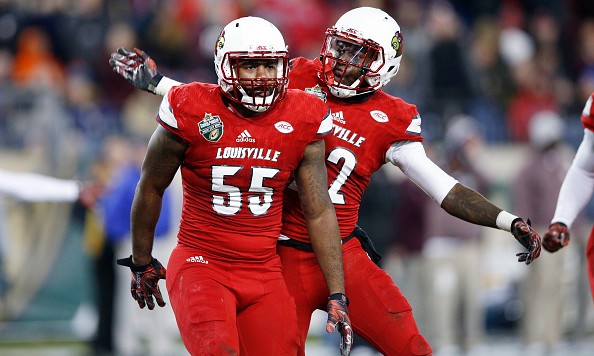Week 3 was a big week in the ACC, which taught us a number of important lessons about the teams in the conference. Here are five takeaways from an action-packed weekend.
5. Georgia Tech can throw the deep ball
Make no mistake about it: the Yellow Jacket offense is a run-first attack. That will always be true as long as Paul Johnson is the head coach. However, the offense works more effectively when there’s the threat of a passing game. While Justin Thomas hit a few clutch throws on the final drive to beat Boston College, it was still uncertain whether the Tech passing game was dangerous enough to keep opposing defenses honest.
Saturday’s contest against Vanderbilt removed all doubt. The Jackets opened the game with a play action pass to Marcus Marshall for an 81-yard touchdown. Later in the game, backup quarterback Matthew Jordan connected on a 77-yard scoring strike with Clinton Lynch, placing the ball perfectly between to Vanderbilt defenders.
These deep strikes are exactly what Georgia Tech needed to see out of its offense before Thursday’s crucial showdown with Clemson, who’s defense has limited opponents to just 2.6 yards per carry this fall.
4. Turnovers are the only thing that can stop the Virginia Tech offense
Two games into the season, it was tough to know exactly how good Virginia Tech’s offense was. Sure, the team moved the ball well against Liberty and Tennessee, but it had trouble holding on to the football. The turnovers prevented us from knowing exactly what the Hokie offense was capable of.
There’s no doubt about it now. Playing against a tough Boston College D that led the nation in total defense last year, the Tech offense moved the ball with ease. The Hokies ran 50 times for 223 yards, while completing 16 of 27 passes for 253 yards and 5 touchdowns. In all, Virginia Tech amassed 476 yards of total offense, which is the second-highest total that BC has allowed in the past two seasons. Only last year’s Clemson squad (532 yards) gained more yardage against the Eagle defense.
That’s quite an accomplishment.
3. Lamar Jackson is a special player
Lamar Jackson 5x better than what I was at V-Tech….Enough said!! #future
— Mike Vick (@MikeVick) September 17, 2016
Coming into this contest, we all knew that Jackson was a great player.
However, we didn’t know that by the end of the game, people would be comparing him to Michael Vick. Facing a Seminole defense that is one of the top units in the conference, Jackson turned in another stellar performance, connecting on 13 of 20 passes for 216 yards and a touchdown, while rushing for 146 yards and four touchdowns.
As awesome as those numbers are, they fail to tell the entire story. Jackson’s ability to run the read option made it almost impossible to stop the Cardinal offense. If the FSU defensive ends crashed down to stop Brandon Radcliff – who ran for 118 yards on 14 carries – Jackson pulled the ball and was off to the races. Yet, when the Seminole D tried to take Jackson away, Radcliff would hurt them with a big run.
Of course, the number that really stands out is that after three games, Jackson is averaging 10.51 yards every time he touches the ball. That’s tops in the nation for players with more than 100 touches.
No wonder Michael Vick tweeted the Jackson is better than he was in college (although there are strong arguments to be made on both sides).
2. Miami’s defense is very good
Many experts had this game circled as a potential upset. After all, Appalachian State was playing at home, and had one the better offenses in the country. Considering that the Mountaineers nearly beat Tennessee on the road in the season opener, they definitely had a shot to win this game, right?
Wrong. For the third straight week, the Miami defense dominated the contest from the opening whistle. The front seven made plays in the App State backfield all day long, recording 12 tackles for a loss and 3 sacks. As a result of this pressure, Mountaineer QB’s completed just 10 of 22 passes, which is only the third time in the past two seasons that they failed to complete at least 50% of their passes.
The UM defense also limited Appalachian State to just 2.6 yards per carry and 2 of 13 on third down conversions.
Simply put: this is one of the top units in a league loaded with great defenses.
1. But, Louisville’s is better
Although Lamar Jackson dominated the headlines on Saturday, Louisville’s defense showed that it is one of the top units in the country. The Cardinal D did an excellent job of getting after the quarterback, recording 5 sacks, 5 hurries, and forcing a number of rushed throws. As a result, Florida State signal callers completed just 8 of 24 passes, and converted just 2 of 13 opportunities on third down.
That’s an outstanding performance considering that the same Seminole squad threw for 419 yards against Ole Miss in the season opener.
Of course, the Cardinal defense has been doing this to opposing defenses all season long. After three games, the Louisville D ranks 14th nationally in completion percentage, 11th in tackles for a loss, and fifth in sacks. It’s also holding opponents to a paltry 4.06 yards per play.
This smothering defense makes Louisville a national championship contender. Even if – and it’s a big if – the offense should struggle this season, Bobby Petrino’s squad has a defense that’s capable of carrying the team to victory.

